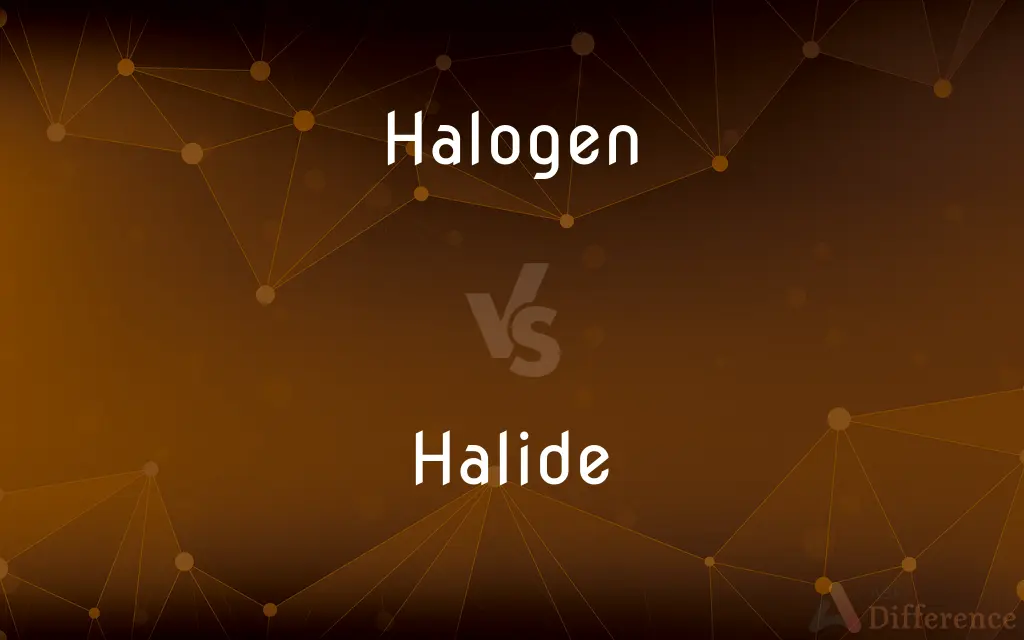Halogen vs. Halide — What's the Difference?
By Urooj Arif & Maham Liaqat — Updated on March 22, 2024
Halogen refers to a group of elements known for their reactivity and electronegativity, whereas halide denotes a compound formed when a halogen gains an electron from another element.

Difference Between Halogen and Halide
Table of Contents
ADVERTISEMENT
Key Differences
Halogens are highly reactive, especially with alkali metals, forming salts. Halides, on the other hand, result from this reactivity, representing the negative ion formed when a halogen atom gains an electron.
Halogens are among the most electronegative elements, eagerly attracting electrons. In contrast, halides are the anions formed when halogens achieve this electron gain, exhibiting ionic characteristics in compounds.
Halogens exist in their elemental form in nature but are rarely found as pure elements due to their reactivity. Halides are more commonly encountered in nature, as in table salt (sodium chloride), where the halogen chlorine is bonded to sodium.
Halogens can be found in all three physical states at room temperature: fluorine and chlorine as gases, bromine as a liquid, and iodine as a solid. Halides are generally found in solid form due to their ionic bonding.
Halogens have various uses, such as in disinfection (chlorine) and lighting (iodine in halogen lamps). Halides are used in many applications, including photographic film (silver halides) and as conductive salts in batteries.
ADVERTISEMENT
Comparison Chart
Nature
Element
Ionic compound or anion
Reactivity
Highly reactive, especially with metals
Formed as a result of halogen reactivity
Electronegativity
Among the highest
Result of halogen gaining an electron
Physical State
Can be gas, liquid, or solid
Typically solid due to ionic bonding
Common Occurrence
Rarely as pure elements, highly reactive
Common in nature, e.g., table salt (NaCl)
Compare with Definitions
Halogen
A non-metal element found in group 17 of the periodic table.
Chlorine is a halogen used in water treatment.
Halide
An ion or compound formed when a halogen gains an electron.
Sodium chloride is a halide where chlorine is the halogen.
Halogen
Known for high reactivity and electronegativity.
The halogen bromine reacts vigorously with metals.
Halide
Generally forms ionic compounds.
Potassium bromide, a halide, is used in photography.
Halogen
Exists in various physical states at room temperature.
Iodine is a solid halogen that sublimates at room temperature.
Halide
Plays a significant role in various applications.
Silver halides are crucial in photographic films.
Halogen
Rarely found in a free state in nature due to reactivity.
Fluorine, the most reactive halogen, is never found free in nature.
Halide
Can be organic or inorganic.
Methyl chloride, an organic halide, is used in chemical synthesis.
Halogen
Used in various applications, including lighting and disinfection.
Halogen lamps use iodine or bromine.
Halide
Commonly found in nature, often as part of minerals.
Fluoride ions in water are halides with potential health benefits.
Halogen
The halogens () are a group in the periodic table consisting of five chemically related elements: fluorine (F), chlorine (Cl), bromine (Br), iodine (I), and astatine (At). The artificially created element 117, tennessine (Ts), may also be a halogen.
Halide
A halide is a binary phase, of which one part is a halogen atom and the other part is an element or radical that is less electronegative (or more electropositive) than the halogen, to make a, e.g., fluoride, chloride, or theoretically tennesside compound. The alkali metals combine directly with halogens under appropriate conditions forming halides of the general formula, MX (X = F, Cl, Br or I).
Halogen
Any of a group of five chemically related nonmetallic elements including fluorine, chlorine, bromine, iodine, and astatine.
Halide
Univalent halogen, or a compound of a halogen, especially a binary compound of a halogen with a more electropositive element.
Halogen
Of or relating to the group of elements that are halogens.
Halide
(chemistry) A salt of any halogen acid.
Potassium iodide is a halide.
Halogen
Of or relating to a bright incandescent light bulb containing a halogen gas that prevents the filament from disintegrating at higher temperatures.
Halide
A salt of any halogen acid
Halogen
(chemistry) Any element of group 17, i.e. fluorine, chlorine, bromine, iodine, astatine and tennessine, which form a salt by direct union with a metal.
Halogen
A light fixture in which the filament is surrounded by an atmosphere of a halogen gas,
Halogen
An electro-negative element or radical, which, by combination with a metal, forms a haloid salt; especially, chlorine, fluorine, bromine, and iodine; sometimes, also cyanogen. See Chlorine family, under Chlorine.
Halogen
Any of five related nonmetallic elements (fluorine or chlorine or bromine or iodine or astatine) that are all monovalent and readily form negative ions
Common Curiosities
Can halogens exist in a free state in nature?
Due to their high reactivity, halogens rarely exist in a free state in nature.
What are common uses of halogens?
Halogens are used in disinfection, lighting, and as reactants in chemical syntheses.
What are halogens?
Halogens are highly reactive, electronegative elements in group 17 of the periodic table.
Are all halides solid?
Most halides are solid due to their ionic bonding, but there can be exceptions.
What defines a halide?
A halide is an ion or compound that forms when a halogen gains an electron.
How are halogens obtained if they're so reactive?
Halogens are obtained through chemical reactions that isolate them from their compounds.
How do halogens and halides differ in reactivity?
Halogens are highly reactive due to their electronegativity, while halides are the result of this reactivity.
What role do halides play in photography?
Silver halides are sensitive to light and are crucial in the development of photographic films.
Are halide ions always negatively charged?
Yes, halide ions carry a negative charge due to the gain of an electron.
Where are halides commonly found?
Halides are commonly found in nature, in compounds like table salt.
Can halides be both organic and inorganic?
Yes, halides can be part of organic compounds (like methyl chloride) or inorganic compounds (like sodium chloride).
How does the reactivity of halogens change across the group?
Reactivity decreases from fluorine to iodine, with fluorine being the most reactive.
Do all halogens form halides?
Yes, all halogens can gain an electron to form halides.
What is the significance of halides in industrial applications?
Halides are used in batteries, photographic films, and other applications due to their chemical properties.
What makes halogens unique among elements?
Their high reactivity and electronegativity make them unique and versatile in chemistry.
Share Your Discovery

Previous Comparison
Maximise vs. Maximize
Next Comparison
Hunter vs. PredatorAuthor Spotlight
Written by
Urooj ArifUrooj is a skilled content writer at Ask Difference, known for her exceptional ability to simplify complex topics into engaging and informative content. With a passion for research and a flair for clear, concise writing, she consistently delivers articles that resonate with our diverse audience.
Co-written by
Maham Liaqat













































